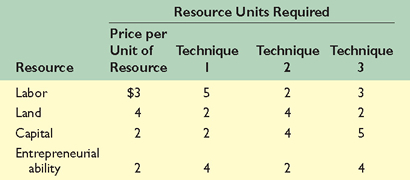Economics (McConnell), 18th EditionChapter 2:
The Market System and the Circular FlowKey Questions1. With current technology, suppose a firm is producing 400 loaves of banana bread daily. Also assume that the least-cost combination of resources in producing those loaves is 5 units of labor, 7 units of land, 2 units of capital, and 1 unit of entrepreneurial ability, selling at prices of $40, $60, $60, and $20, respectively. If the firm can sell these 400 loaves at $2 per unit, will it continue to produce banana bread? If this firm's situation is typical for the other makers of banana bread, will resources flow to or away from this bakery good? 2. Assume that a business firm finds that its profit is greatest when it produces $40 worth of product A. Suppose also that each of the three techniques shown in the table below will produce the desired output: - With the resource prices shown, which technique will the firm choose? Why? Will production using that technique entail profit or loss? What will be the amount of that profit or loss? Will the industry expand or contract? When will that expansion or contraction end?
- Assume now that a new technique, technique 4, is developed. It combines 2 units of labor, 2 of land, 6 of capital, and 3 of entrepreneurial ability. In view of the resource prices in the table, will the firm adopt the new technique? Explain your answer.
- Suppose that an increase in the labor supply causes the price of labor to fall to $1.50 per unit, all other resource prices remaining unchanged. Which technique will the producer now choose? Explain.
- "The market system causes the economy to conserve most in the use of resources that are particularly scarce in supply. Resources that are scarcest relative to the demand for them have the highest prices. As a result, producers use these resources as sparingly as is possible." Evaluate this statement. Does your answer to part c, above, bear out this contention? Explain.
 <a onClick="window.open('/olcweb/cgi/pluginpop.cgi?it=jpg::::/sites/dl/free/0025694212/668709/KeyQuestion_Ch02_Graph01.jpg','popWin', 'width=NaN,height=NaN,resizable,scrollbars');" href="#"><img valign="absmiddle" height="16" width="16" border="0" src="/olcweb/styles/shared/linkicons/image.gif"> (41.0K)</a> <a onClick="window.open('/olcweb/cgi/pluginpop.cgi?it=jpg::::/sites/dl/free/0025694212/668709/KeyQuestion_Ch02_Graph01.jpg','popWin', 'width=NaN,height=NaN,resizable,scrollbars');" href="#"><img valign="absmiddle" height="16" width="16" border="0" src="/olcweb/styles/shared/linkicons/image.gif"> (41.0K)</a>3. Some large hardware stores such as Home Depot boast of carrying as many as 20,000 different products in each store. What motivated the producers of those individual products to make them and offer them for sale? How did the producers decide on the best combinations of resources to use? Who made those resources available, and why? Who decides whether these particular hardware products should continue to be produced and offered for sale?  Chapter 02 Key Question Solutions
(38.0K) Chapter 02 Key Question Solutions
(38.0K)
 | 

















